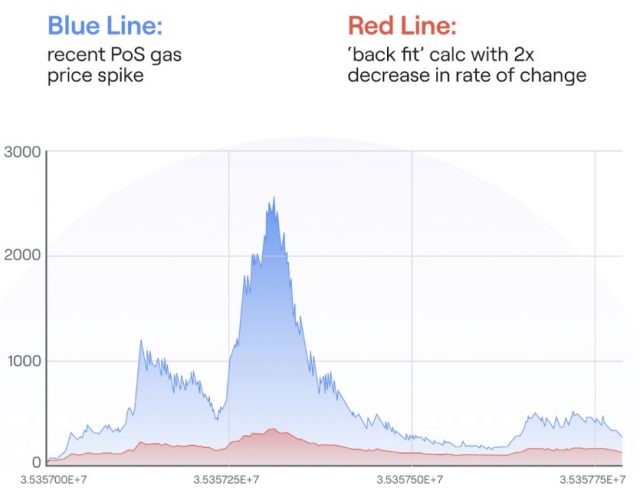
Porygon to hard fork
The crypto asset (virtual currency) Ethereum (ETH) scaling solution “Polygon (MATIC)” will implement a hard fork with a block height of 38,189,056, which is scheduled to reach on the 17th.
Block number at time of writing is 38,180,789. In Pochigon, one block is generated every two seconds, so a hard fork is expected to take place around 20:00 on January 17, Japan time.
 What’s all the buzz about?
What’s all the buzz about? Why does the Polygon PoS chain need a hardfork?
Why does the Polygon PoS chain need a hardfork? How’s it unfolding?
How’s it unfolding? Do I need to do anything?
Do I need to do anything?
Here’s everything you need to know about the proposed hardfork for the Polygon PoS chain on 01/17  pic.twitter.com/xF3SvUb2eu
pic.twitter.com/xF3SvUb2eu
— Polygon (@0xPolygon) January 16, 2023
This hard fork has two purposes. Measures to reduce soaring transaction fees (gas prices) and deal with blockchain reorganization (reorg). These will improve network performance and security. A fork will not create a new cryptocurrency with chain branching.
Like Ethereum, Polygon uses “on-chain gas dynamics,” in which the transaction fee (gas) fluctuates according to the frequency of network usage. However, Polygon’s block generation time is about 2 seconds, which is faster than Ethereum (~ 15 seconds), so the “base fee” portion tended to rise exponentially.
The base fee is calculated by an algorithm according to the free space of each block and burned. Distinguished from priority fees (tips) specified by the user and resulting in minor revenue. The hard fork will adjust the parameters of the gas calculation formula to moderate the fluctuation rate of the base fee (12.5% → 6.25%) when the actual utilization rate exceeds the target utilization rate.

Source: Polygon
In addition, the block generation time for a single validator will be changed from 128 seconds to 32 seconds, and the number of blocks (sprint length) to reach finality as a network will be reduced from the current 64 blocks to 16 blocks. .
These measures are intended to reduce the depth of reorganization (reorgs) and to reduce the likelihood of a second or third validator simultaneously intervening in block generation. Note that the total number and time of blocks generated by validators is not affected, so the validator rewards generated before and after the hard fork will not change.
Relation:Solana NFT “y00ts” receives 400 million yen subsidy from Polygon
A reorganization (reorg) is a chain divergence that occurs when two blocks are mined (generated) at the same time in a decentralized blockchain network. The longer chain in terms of number of subsequent blocks is considered normal and the other chain is deleted. This leads to adverse effects such as degraded user experience such as transaction delays and uncertainties, and increased node costs.
All in all, this upgrade to Polygon is expected to improve performance and predictability for users, validators, and developers.
Relation:Polygon (MATIC), developers propose hard fork
Expanded adoption of polygons
11. [Transactions on EVM Chains]
Activity on (almost) all EVM blockchains has decreased.
BNB Chain has lost >60% in tx’s activity.
The activity on Avalanche has greatly dropped down as well.
Polygon, Ethereum, Fantom, and Celo blockchains remain on the same levels as 1 year ago. pic.twitter.com/SKnRYzsxWV
— DEFIYIELD.App (@defiyield_app) January 3, 2023
Over the past year, Polygon has been partnered with and hired by a number of major companies. Major brands such as Starbucks, Coca-Cola, Disney, Nike, and Instagram have launched NFT projects on Polygon, creating network effects.
Perhaps due to this influence, Polygon has maintained a high ranking in terms of the number of transactions among Ethereum Virtual Machine (EVM) compatible chains.
3.Network effects
Some of the biggest brands in the world have launched NFTs on Polygon.
This makes it easy for the Polygon team to attract other brands to their blockchain.
Polygon has become the default choice for big brands to build on because of this. pic.twitter.com/HeJgRChMq5
—Lamboland (@LambolandNFT) January 9, 2023
On January 6th, Mastercard, a major payment company, announced the “Mastercard Artist Accelerator”, a Web3 (distributed web) development program for music artists. It was revealed that it would use the Polygon (MATIC) blockchain as its foundation.
Relation:Mastercard Announces Music NFT Accelerator, Adopts Polygon
The post Polygon (MATIC) hard fork expected on January 17th appeared first on Our Bitcoin News.

 2 years ago
145
2 years ago
145














 English (US) ·
English (US) ·